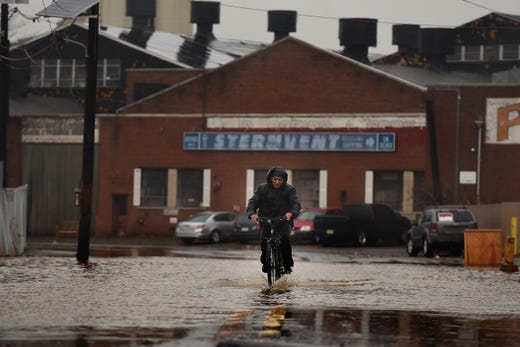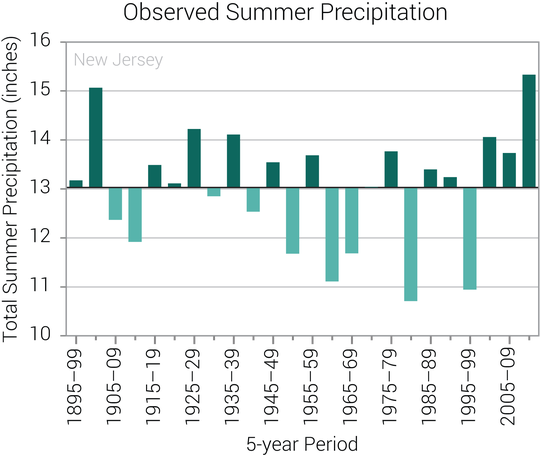
Many cellphones in North Jersey squawked alerts repeatedly this summer about potential flash floods, as fast, heavy downpours inundated roadways, damaged property and forced first responders to rescue stranded motorists.
As climate change exacerbates flooding, New Jersey’s vulnerable inland communities have made few tangible strides to improve their resiliency by upgrading roadway storm drains, experts say.
Flooding has long been a problem in North Jersey, but decades-old storm drains, pipes and other infrastructure have proved to be even less effective in recent years as heavy rains become more common.
New Jersey was pummeled with more precipitation in 2018 than in any other year since record keeping began in 1895, and state officials expect that to continue.
Plans to deal with increased inland flooding abound — at both the state and municipal levels.
But infrastructure is expensive, so replacing old stormwater systems is slow going in cash-strapped communities where such projects are”a lower priority in terms of funding,” said George Guo, a water resources engineer at Rutgers University.
“Many of our communities have not even kept good track of the aged infrastructure,” Guo said. “We do not have good maintenance programs, either.”
New Jersey’s standards for the size of stormwater infrastructure on any new state-funded projects were upgraded in the years after Superstorm Sandy, so some newer stormwater pipes can handle greater volumes of water.
Since the 1960s, development rules in New Jersey and many places in the United States centered around the 100-year flood standard — infrastructure must be able to handle the amount of water produced by a storm so rare that it has a 1% chance of occurring in a given year.
But the standard had become inadequate, since climate change is making such storms more common, causing increased flooding, whether from inundating rains or the sort of tidal storm surge that wrecked havoc along the Jersey Shore, in the Meadowlands and in Hoboken during Sandy in 2012.

“There have been many 100-year storms that have hit New Jersey in the last few decades,” said Chris Sturm, a water policy expert with New Jersey Future, a nonprofit that advocates a balance between economic development and environmental protection. “That will only increase with climate change.”
Flash floods, however, aren’t accounted for in model storms. Their speed frustrates attempts to track how they flow through sewer systems.
The lack of modelsto measure the flow from such storms makes it hard to design infrastructure that can handle them,said Zenon Tech-Czarny, a researcher at Sustainable Jersey, an environmental non-profit.
Another factor feeding the lack of preparedness is the limited coordination and funding in municipalities that would most benefit from flash-flood-fighting projects and regulations, experts said.
Standards also depend on where the money is coming from.
In 2015 President Barack Obama issued an executive order designed to make federally funded road and bridge projects more resilient by requiring that they be built at least 2 feet above the 100-year flood elevation or to the 500-year flood elevation.
Then, in 2017, President Donald Trump issued an executive order blocking Obama’s requirements for such projects.
Despite the rollback, New Jersey is still requiring all infrastructure projects that receive state funding to be built above the 500-year flood elevation, said Larry Hajna, a spokesman for the state Department of Environmental Protection.
Mixing gray with green
Studies on climate change and infrastructure are common in New Jersey. Implementation is another matter.
Take the central section of the Passaic River Basin, an area made up of Wayne, Lincoln Park, Pequannock, Pompton Lakes, and Fairfield, which has suffered major flooding going back centuries because it is essentially a prehistoric lake bed.
Steps to make key highways and other infrastructure in the Passaic Basin more resilient, such as upgrading drainage systems to accommodate more stormwater, would cost nearly $125 million, according to a study released in June by the North Jersey Transportation Planning Authority.
The cost estimate is based on current national averages, although it’s unlikely that the recommendations would be implementedall at once. And the NJTPA has no power to mandate the improvements. That’s the role of such agencies as the New Jersey Department of Transportation, NJ Transit and the Port Authority.
Passaic County adopted a green infrastructure plan in June 2018 that recognizes its shortcomings. “The county currently has no requirements for water quality, ground water recharge, or control of the smaller, more frequent storm events that cause localized nuisance flooding and stream channel degradation,” the plan reads.
And that plan, which goes on for more than 200 pages, has no real teeth. “It is not meant as a specific implementation plan,” said Michael Lysicatos, director of the county’s Department of Planning and Development.
Hoboken has implemented small-scale green infrastructure as it prepares for future threats, including rain gardens, green roofs and bioretention basins, said Caleb Stratton, Hoboken’s chief resilience officer. Although Hoboken is a coastal area, green infrastructure can be applied almost anywhere.
The concrete driveways and parking lots that come with development eliminate the ability for vegetation and the earth to absorb rainwater, and instead cause it to flow more quickly into local streams and rivers, inundating them so that they overflow their banks and flood roads and buildings.If green infrastructure is applied to entire watersheds, it could “mitigate significantly” the flash flood threat because it would restore the natural hydrology, Guo said.
This, he added, “would be a very expensive proposition.”
Old systems that combine sewer and stormwater pipes create additional problems with increased rainfall. Heavy rain causes billions of gallons of sewage-fouled water to flow into the Hudson, Hackensack and Passaic rivers each year.
The cost to replace this 19th-century technology is well above the capacity of most municipalities, with estimates ranging from $100 million for Ridgefield Park to $1 billion for Paterson.
Towns with heavy flooding could be aided by a new law that would allow them to upgrade their stormwater infrastructure by charging a fee on the owners of properties such as strip malls with large parking lots that cause excessive runoff.
Opponents have dubbed it a “rain tax,” but supporters — including almost every major environmental group in New Jersey — say it’s an opportunity to provide funding where little or none exists.
“I think, under that bill, they could address the whole concept of capacity,” said John Scagnelli, an environmental attorney for the New Jersey League of Municipalities.
Once the DEP provides guidance for the rule, he said, he thinks “it will provide a mechanism for addressing various issues.” The DEP said it should post guidance on its website about the rule by early 2020.
Hoboken’s flooding projects are funded with $230 million from the federal Rebuild by Design program, Stratton said, as well as $180 million from the city, pulled from general obligation bonds, a municipal tax, government grants and the state’s infrastructure bank.
The new rule “shouldn’t be a barrier to entry” for local governments that want to engage in flood-prevention projects, Stratton said.
The article includes a slideshow, video, and text. Click here to view the original presentation (paywall).
This story was produced in collaboration with the New Jersey Sustainability Reporting Hub project. It was originally reported by Alexis Shanes for northjersey.com, and may be re-distributed through the Creative Commons License, with attribution.
